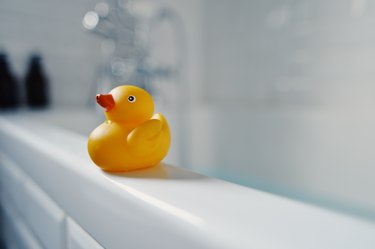
Cleaning a tub surround can seem like a daunting task because there's generally a lot of area to cover, although the surround doesn't tend to get as dirty as the tub itself. Whether your tub surround needs a basic wipe down or a significant scrubbing with a heavy-duty bathtub cleaner, there's no getting around the physical effort involved.
To choose the best bathtub cleaner and tools for a plastic tub surround, understand that plastic, or acrylic, is softer and more easily scratched than porcelain-enamel and fiberglass. Don't assume enamel and fiberglass tub cleaners and polishes are suitable for plastic as well. Make sure to only use nonabrasive products on it, and you will keep the plastic tub surround looking clean and in good condition for as long as possible.
Video of the Day
Video of the Day
The Best Bathtub Cleaner Without Scrubbing
Acrylic or plastic bathtubs and tub surrounds call for nonabrasive cleaning products only. If you want to use a commercial product, consider all-purpose cleaners or bathroom-specific cleaners. However, it's important to check the label for the description "nonabrasive" and "suitable for acrylic, plastic, polystyrene, ABS, etc." You don't necessarily need to rule out use of enamel or fiberglass tub cleaner and polish nor heavy-duty bathtub cleaners, as there's a chance they are safe to use on plastic too. Cleaning products vary considerably in their ingredients even from the same brand, so just be sure to double-check before using these products on plastic.
Alternative cleaning products suitable for use on a plastic tub surround include dish soap, white vinegar and household bleach.
Cleaning Products to Avoid
Do not use abrasive cleaners or solvents on a plastic tub surround, as they can permanently damage it. Some brands of enamel and fiberglass cleaner and polish products are abrasive, while others are not. Abrasive cleaners include any commercial products that are not clearly labeled "nonabrasive" or as safe for acrylic or plastic as well as DIY cleaners, such as baking soda scrubs. Solvents, which you should never use on plastic tub surrounds, include mineral spirits, turpentine and acetone.
The Best Cleaning Tools
Any soft, nonabrasive cleaning tool, such as a microfiber or terry cloth towel, and a sponge, rag, scrubber or brush labeled "nonabrasive" can be used to clean a plastic tub surround without risk of scratching it. Tools you should never use include steel wool, scouring pads and melamine sponges. If you're using a commercial bathtub cleaner, especially a heavy-duty bathtub cleaner or household bleach, always wear protective gloves and ideally open bathroom windows and doors for ventilation. Gloves are optional if you're cleaning with vinegar or dish soap.
How to Clean a Plastic Tub Surround
To clean a plastic tub surround with a commercial cleaner, follow the manufacturer's directions, which will generally tell you to spray or wipe the product liberally over the surfaces, let it sit for a certain amount of time and then rinse with water. Some of the best bathtub cleaners without scrubbing are effective, but others will need to be used with some scrubbing action, especially if the surround is visibly dirty or stained.
If you're using dish soap, mix a generous squeeze of the soap into a basin of warm water; soak your cloth, sponge or other tool in the soapy water; and apply it all over the tub surround. Scrub if necessary and then rinse with plain water. With white vinegar, spray it all over the tub surround or soak your cloth with the vinegar and wipe it over the surfaces before rinsing. Bleach should be diluted in water with approximately equal parts of each, sprayed or wiped on the surfaces and then rinsed with water. You might let the vinegar or bleach sit on the surfaces for 15 or more minutes before scrubbing and rinsing for extra cleansing power.